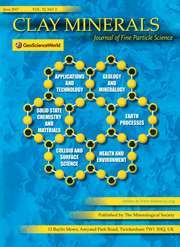Article contents
Mineral associations in ore deposits
Published online by Cambridge University Press: 14 March 2018
Abstract
Association of minerals such as zincblende, galena, chalcopyrite, pyrite, quartz, illite and chlorite (magnesium-rich type) has been observed in ores and also in the alteration zone adjacent to ore bodies of “Kurokō” (the black ore) deposits in Japan. Recently, in some ore bodies, detailed mineralogical studies have shown that non-metallic minerals in ores and the adjacent alteration zone are those poor in magnesium, iron and potassium, such as pyrophyllite, kaolinite, diaspore, quartz, 26 Å- and 30 Å-clay minerals. The 26 Å-clay mineral is a mixed-layer mineral of illite and its hydrated form. The 30 Å-clay mineral is a regularly interstratified montmorillonite-(aluminous) chlorite clay mineral. The presence of brucite is also usually suggested. An environmental condition to form ore deposits with such a mineral association may be a leaching condition, under which ions such as magnesium, iron and potassium were liable to be partially leached away or to precipitate as hydroxides rather than to form silicates such as illite or chlorite.
- Type
- Research Article
- Information
- Copyright
- Copyright © The Mineralogical Society of Great Britain and Ireland 1958
References
- 11
- Cited by


